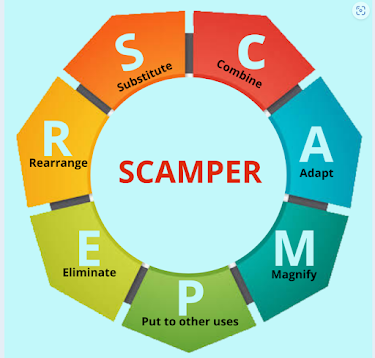Innovative Idea Generation Techniques for Entrepreneurial Ventures
As chemistry students, you are constantly engaged in experimentation, analysis, and discovery skills that align closely with the mindset of an entrepreneur. Entrepreneurship isn’t limited to business students. Scientists, particularly chemists, are uniquely positioned to identify problems and create innovative solutions.
Why Innovation Matters in
Chemistry-Based Entrepreneurship?
- Drives the development of new materials,
pharmaceuticals, and eco-friendly products.
- Enhances commercial viability of lab discoveries.
- Bridges the gap between scientific research and market needs.
1. Brainstorming
Definition: A group creativity technique where individuals share ideas
freely without criticism.
Application for Chemistry:
- Gather a group of peers to discuss everyday lab
problems (e.g., waste management, chemical storage).
- Encourage "wild" ideas that could lead to
breakthrough products.
Example: Brainstorming led to the creation of biodegradable lab utensils.
2. SCAMPER Technique
SCAMPER stands for: Substitute, Combine, Adapt, Modify, Put to
another use, Eliminate, and Reverse.
Application for Chemistry:
- Substitute
a raw material with a green alternative.
- Combine
properties of two chemicals to make a new compound.
Example: A student modified an existing air filter with activated carbon and herbs to increase efficiency.
3. Reverse Thinking
Definition: Think in the opposite direction of conventional solutions.
Application for Chemistry:
- Ask: "What if we wanted to create a material that
absorbs pollutants instead of releasing them?"
Example: Led to innovations in pollution-absorbing concrete.
4. Market Gap Analysis
Definition: Identifying areas where customer needs are not currently
being met.
Application for Chemistry:
- Research consumer pain points in areas like skincare,
cleaning agents, or pharmaceuticals.
Example: Developing an anti-bacterial handwash with all-natural compounds based on market demand.
5. Trend Analysis
Definition: Observe emerging trends and adapt them to your field.
Application for Chemistry:
- Track sustainability trends and apply them in chemical
formulations.
Example: Creating plastic alternatives from corn starch in response to eco-conscious consumer behavior.
6. Problem-Solution Fit
Definition: Identify a specific problem and develop a targeted
solution.
Application for Chemistry:
- Is there a recurring challenge in your lab? Can you
design a product to solve it?
Example: A student created a cost-effective chemical spill neutralizer for school labs.
7. Innovation through Collaboration
Definition: Work with professionals from other disciplines.
Application for Chemistry:
- Collaborate with IT students to develop apps for
chemical safety.
Example: An app that gives real-time chemical hazard alerts in the lab.
Conclusion
Innovation is the lifeblood of
entrepreneurship, and as chemistry students, you hold the tools to solve some
of the world’s pressing problems. By applying idea generation techniques like SCAMPER,
reverse thinking, market gap analysis, and brainstorming, you can
transform your scientific insights into impactful ventures.



